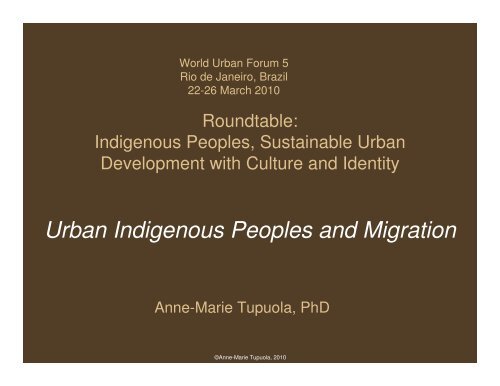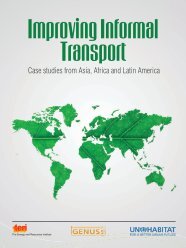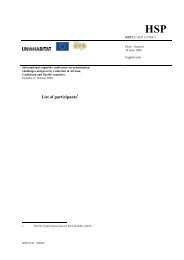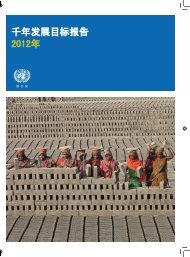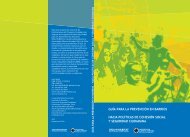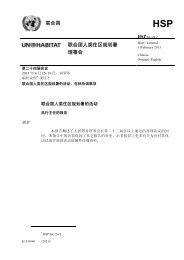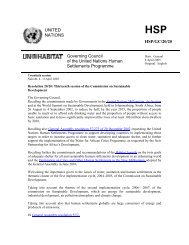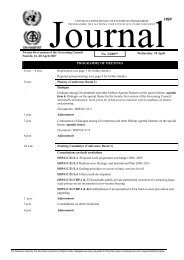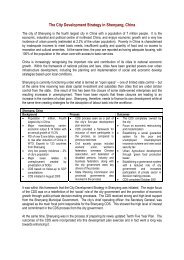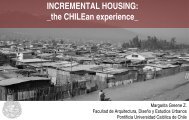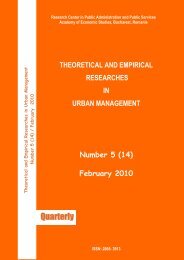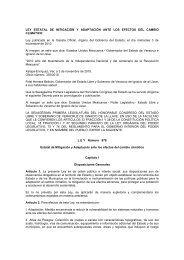Urban Indigenous Peoples and Migration - UN-Habitat
Urban Indigenous Peoples and Migration - UN-Habitat
Urban Indigenous Peoples and Migration - UN-Habitat
You also want an ePaper? Increase the reach of your titles
YUMPU automatically turns print PDFs into web optimized ePapers that Google loves.
World <strong>Urban</strong> Forum 5<br />
Rio de Janeiro, Brazil<br />
22-26 March 2010<br />
Roundtable:<br />
<strong>Indigenous</strong> <strong>Peoples</strong>, Sustainable <strong>Urban</strong><br />
Development with Culture <strong>and</strong> Identity<br />
<strong>Urban</strong> <strong>Indigenous</strong> <strong>Peoples</strong> <strong>and</strong> <strong>Migration</strong><br />
Anne-Marie Tupuola, PhD<br />
©Anne-Marie Tupuola, 2010
Brief Bio<br />
Dr Anne-Marie Tupuola is of Samoan descent born in New<br />
Zeal<strong>and</strong> with indigenous <strong>and</strong> ancestral ties to Samoa’s<br />
villages of Lotofaga, Tufuiopa <strong>and</strong> Vaigaga.<br />
She specialises <strong>and</strong> has published extensively in the areas of<br />
human development, adolescent psychology, youth studies,<br />
gender studies, indigenous health <strong>and</strong> well-being, research<br />
methods, scholarship <strong>and</strong> epistemologies.<br />
Anne-Marie has been affiliated with Columbia, Harvard <strong>and</strong><br />
New York Universities as a Fulbright Senior Scholar <strong>and</strong> was<br />
Visiting Professor <strong>and</strong> Visiting Scholar at New York University<br />
<strong>and</strong> Teachers College, Columbia University where she was<br />
awarded an Outst<strong>and</strong>ing Teachers Award.<br />
Dr Tupuola currently resides in London, UK <strong>and</strong> is Principal of<br />
Global Edge Research, an independent scholar, consultant,<br />
researcher, lecturer <strong>and</strong> freelance writer.
Context<br />
“<strong>Indigenous</strong> peoples should not be seen as divided<br />
between urban <strong>and</strong> rural, but rather as connected peoples with common<br />
cultural identities.” i<br />
• <strong>Urban</strong>isation is a reality for many indigenous peoples. However, this urban<br />
reality is not well documented nor fully understood within appropriate<br />
indigenous contexts.<br />
• The urban migration process of indigenous peoples has received increasing<br />
interest. However, the process of urban migration itself is often simplified<br />
with much attention paid to the rural-urban migration process.<br />
• Some indigenous peoples are moving from one urban location to another<br />
<strong>and</strong> some generations of indigenous peoples have only ever lived in the<br />
city.<br />
©Anne-Marie Tupuola, 2010
EGM, Santiago, Chile, March 2007<br />
• Recognition of human rights.<br />
• Improve the livelihood, living conditions,<br />
well-being <strong>and</strong> quality of life of<br />
indigenous peoples.<br />
• Self-sufficiency, self-determination <strong>and</strong><br />
governance <strong>and</strong> greater inclusion <strong>and</strong><br />
participation of indigenous peoples in the<br />
decision-making process.<br />
• Examine <strong>and</strong> analyse the urban<br />
experiences of indigenous peoples within<br />
an indigenous holistic framework.<br />
©Anne-Marie Tupuola, 2010
<strong>Urban</strong> <strong>Indigenous</strong> <strong>Peoples</strong> <strong>and</strong> <strong>Migration</strong> Report<br />
• Issues, debates at the EGM shaped,<br />
facilitated <strong>and</strong> guided the direction <strong>and</strong><br />
methodology.<br />
• Increasing numbers of indigenous peoples<br />
are migrating to <strong>and</strong> settling in urban areas.<br />
• Complex <strong>and</strong> paradoxical nature of urban<br />
migration processes <strong>and</strong> the so-called<br />
‘urban dream’.<br />
©Anne-Marie Tupuola, 2010
<strong>Urban</strong> <strong>Migration</strong><br />
• <strong>Urban</strong> migration processes vary.<br />
• Caution against simplifying urban<br />
migration processes.<br />
• Heterogeneous experience for<br />
indigenous peoples.<br />
Torika Bolatagici, Self Portrait, 2001<br />
The nature of the migration process is<br />
difficult to define in a single<br />
framework… as urban indigenous<br />
people’s identities become increasingly<br />
fluid, the tendency to compartmentalise<br />
the migration experience according to<br />
push-pull factors, rural or urban,<br />
voluntary or forced, becomes difficult<br />
<strong>and</strong> less clear cut. ii<br />
©Anne-Marie Tupuola, 2010
<strong>Urban</strong>isation<br />
• <strong>Urban</strong>isation is not new to<br />
indigenous peoples.<br />
• Caution against overstating the<br />
rural connections of indigenous<br />
peoples at the cost of<br />
undervaluing their urban<br />
counterparts.<br />
• Recognise <strong>and</strong> acknowledge the<br />
number of indigenous peoples<br />
who have always lived in the city.<br />
Policy makers often think of <strong>Indigenous</strong><br />
<strong>Peoples</strong> as living in the country-side, ….<br />
It often comes as a big surprise when<br />
they discover that huge numbers of<br />
<strong>Indigenous</strong> <strong>Peoples</strong> reside in major<br />
cities... urbanization has been around<br />
since time immemorial for many<br />
<strong>Indigenous</strong> <strong>Peoples</strong> – for example, think<br />
about the ancient urbanization of Central<br />
<strong>and</strong> South America <strong>and</strong> Michu Pichu [sic]<br />
in Peru comes to mind. iii<br />
...it is equally important to recognize that<br />
increasingly many members of<br />
indigenous peoples… have known no<br />
other home than the urban centres <strong>and</strong><br />
there needs to be space within the<br />
dialogue to consider their views <strong>and</strong><br />
issues. The failure to do so would<br />
exclude a large (<strong>and</strong> growing) number of<br />
indigenous peoples. iv<br />
©Anne-Marie Tupuola, 2010
Challenges<br />
• Feminisation of poverty. v<br />
• Violation of l<strong>and</strong> rights.<br />
• Myth of the urban dream.<br />
• Misappropriation <strong>and</strong> exploitation<br />
of indigenous cultures, skills <strong>and</strong><br />
wares.<br />
• Discrimination (cultural, racial,<br />
gender <strong>and</strong> disability), inequality<br />
<strong>and</strong> intra-cultural identity politics.<br />
…while the city can offer economic mobility<br />
<strong>and</strong> social development... [it can] also<br />
generate <strong>and</strong> intensify social exclusion,<br />
limiting the benefits of urban life to...<br />
indigenous peoples… As such, the<br />
human rights of indigenous peoples,<br />
particularly regarding their living<br />
conditions <strong>and</strong> quality of life, are often<br />
compromised. vi<br />
…in urban cities, indigenous peoples rely on<br />
the informal sector to market their wares<br />
which often amounts to the<br />
commoditisation of indigenous culture<br />
<strong>and</strong> skills… Even though it is the<br />
indigenous cultures that are advertised to<br />
lure <strong>and</strong> entice tourists, their<br />
remuneration does not reflect this... vii<br />
©Anne-Marie Tupuola, 2010
Resilience <strong>and</strong> Ingenuity of <strong>Urban</strong> <strong>Indigenous</strong><br />
<strong>Peoples</strong><br />
• Young people illustrate the possibility to<br />
preserve indigenous identities while<br />
maximising the benefits of urban<br />
society.<br />
• <strong>Indigenous</strong> youth, through indigenous<br />
popular culture, are self-appointed<br />
cultural custodians to protect the<br />
integrity <strong>and</strong> ownership of indigenous<br />
cultures, skills, knowledge <strong>and</strong><br />
traditions.<br />
• Effective best practices <strong>and</strong><br />
programmes by indigenous peoples<br />
that adopt pro-active, rights based <strong>and</strong><br />
holistic strategies to improve the<br />
education, health, livelihood, quality of<br />
life <strong>and</strong> economic capacity of<br />
indigenous peoples.<br />
Torika Bolatagici, untitled, 1999<br />
©Anne-Marie Tupuola, 2010
Recommendations<br />
“Why many initiatives have proven unsuccessful relates to the fact<br />
that they were developed for the people, not with the people” viii<br />
• <strong>Urban</strong>isation is a phenomenon that governments, local authorities <strong>and</strong> States have to<br />
recognise to ensure that indigenous peoples are not forcibly removed or driven from<br />
their homel<strong>and</strong>s, nor subject to discrimination once in urban areas.<br />
• The diversity of indigenous peoples in urban areas must be recognised. <strong>Indigenous</strong><br />
peoples are not a static population but have increasingly multiple identities.<br />
• Policy must comply with the principles of the ILO Convention no. 169 <strong>and</strong> the United<br />
Nations Declaration of the Rights of <strong>Indigenous</strong> <strong>Peoples</strong> to eliminate discrimination,<br />
inequality <strong>and</strong> the violation of human rights of indigenous peoples in urban areas.<br />
• Governments <strong>and</strong> local authorities must consult with <strong>and</strong> ensure the participation of<br />
indigenous peoples at all phases of policy formulation process. They must also ratify<br />
<strong>and</strong> comply with the principles of the Declaration of the Rights of <strong>Indigenous</strong> <strong>Peoples</strong><br />
<strong>and</strong> ILO Convention no. 169 to ensure indigenous peoples are equal partners in the<br />
decision-making process <strong>and</strong> they comply with free, prior <strong>and</strong> informed consent on all<br />
matters that concern <strong>and</strong> affect indigenous peoples in urban areas.<br />
©Anne-Marie Tupuola, 2010
Recommendations<br />
• Governments must take steps to provide the necessary resources so that<br />
indigenous peoples can achieve the full <strong>and</strong> progressive realisation of their<br />
rights to adequate housing, to eliminate homelessness <strong>and</strong> to provide<br />
necessary services, especially for the disabled, women <strong>and</strong> youth.<br />
• Systems of accountability should be considered as part of policy<br />
development to address non-compliance with national <strong>and</strong> international<br />
rights of indigenous peoples.<br />
• Holistic frameworks should be recognised <strong>and</strong> implemented so that<br />
housing, health, employment <strong>and</strong> education are not assessed in isolation.<br />
Outcomes should be long term.<br />
• <strong>Indigenous</strong> peoples should not be seen as divided between urban <strong>and</strong> rural,<br />
but rather as people with rights <strong>and</strong> a common identity, adapting to<br />
changing circumstances <strong>and</strong> environments.<br />
©Anne-Marie Tupuola, 2010
References/Notes<br />
References:<br />
<strong>UN</strong>-<strong>Habitat</strong> <strong>and</strong> OHCHR, (2007). “<strong>Urban</strong> <strong>Indigenous</strong> <strong>Peoples</strong> <strong>and</strong> <strong>Migration</strong>: Report <strong>and</strong><br />
full account of the International Expert Group Meeting 27-29 March 2007, Santiago,<br />
Chile”, Nairobi: <strong>UN</strong>-<strong>Habitat</strong>.<br />
<strong>UN</strong>-<strong>Habitat</strong> <strong>and</strong> OHCHR, (2010). “<strong>Urban</strong> <strong>Indigenous</strong> <strong>Peoples</strong> <strong>and</strong> <strong>Migration</strong>: A Review of<br />
Policies, Programmes <strong>and</strong> Practices”, Nairobi: <strong>UN</strong>-<strong>Habitat</strong>.<br />
Notes:<br />
i. <strong>UN</strong>-<strong>Habitat</strong> <strong>and</strong> OHCHR, 2010: xiii.<br />
ii. <strong>UN</strong>-<strong>Habitat</strong> <strong>and</strong> OHCHR, 2010: 2.<br />
iii. Littlechild, 2007: 1 cited in <strong>UN</strong>-<strong>Habitat</strong> <strong>and</strong> OHCHR, 2010: 9.<br />
iv. <strong>UN</strong>-<strong>Habitat</strong> <strong>and</strong> OHCHR, 2007: 10.<br />
v. Brite Scholz (2005) in <strong>UN</strong>-<strong>Habitat</strong> <strong>and</strong> OHCHR, 2010.<br />
vi. <strong>UN</strong> Doc PFII/2006/WS.3/9: p.2; <strong>UN</strong>-<strong>Habitat</strong> <strong>and</strong> OHCHR, 2010: 23.<br />
vii. Kipuri, 2007: 8 cited in <strong>UN</strong>-<strong>Habitat</strong> <strong>and</strong> OHCHR, 2010: 25.<br />
viii. Rust, 2009: 2 cited in <strong>UN</strong>-<strong>Habitat</strong> <strong>and</strong> OHCHR, 2010: 29.<br />
©Anne-Marie Tupuola, 2010


